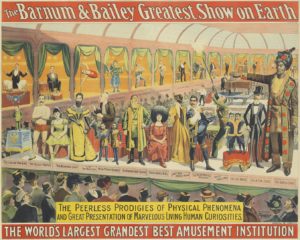
When the movie The Greatest Showman came out in 2017, people flocked to the theaters to see a film full of catchy songs, glamour, and, to be honest, Zac Efron. While I have to admit that the movie was a great production, what hasn’t been discussed enough is the fact it downplayed the true story that inspired the film: Phineas Taylor Barnum used people and their out-of-the-ordinary qualities to make a profit.
In 1841, Barnum purchased the American Museum and made people the major attraction, in what soon became known as a “freak show.” Those a part of the show included, midgets, the bearded lady, “giants”, Siamese twins, contortionists, and other people with obvious physical abnormalities like excessive amounts of tattoos or albinism. P.T. Barnum was a master at marketing, and he understood what would get people to come to his museum. He promoted his shows by not focusing his advertisements and shows on the performers themselves, but their qualities instead. As the movie shows well, these performers were ashamed of the way they looked. Society didn’t accept them for who they were, at the time, because they didn’t match what people believed to be the image of normal. When each of them met P.T. Barnum, he made a promise that he would save them and provide for them, but in my opinion, he was merely thinking about himself. He benefited from the exploitation of people’s insecurities, and it was a very selfish scheme. He became famous and rich, using his performers as means to achieve those goals while targeting the elite and their infatuation with the extraordinary.

It’s obvious that we are all excited and entranced by the idea of things out-of-the-ordinary. I think about Area 51 and aliens, and how people are so quick to form obsessions around things that simply don’t make sense. That is normal. We are attracted to things that make us think and ponder the idea that what we know, is nowhere near what is possible. The thing I love about the past few decades is that society is slowly, but surely, becoming more accepting of people’s differences. In fact, I think it’s safe to say that we are now rather accepting of them. I don’t think it is, or was, wrong to profit from extraordinary things, but where I think P.T. Barnum went wrong is that he did so at the expense of other people. Yes, the performers were paid and taken care of, but they were used for entertainment because of aspects of their lives that were uncontrollable, rather than because of who they were or their abilities.
Using people as subjects of museum exhibits seems innocent from afar but understanding the exploitation that occurred shows a darker side of what the entertainment industry used to be.








Hi Taryn!
Something that your post made me think about is whether or not the individuals in the freak show saw their involvement as exploitation or representation. I wonder if seeing the “different” or “abnormal” people such as women with facial hair, people with albinism, etc. makes others with those feature be more seen. But it’s good to question where the line is? Are these people contributing with full informed consent? Another ethical concern with the way P.T. Barnum used the individuals in his show, is that they were reduced simply to their oddity; they weren’t allowed to be more than what made them “wrong.”